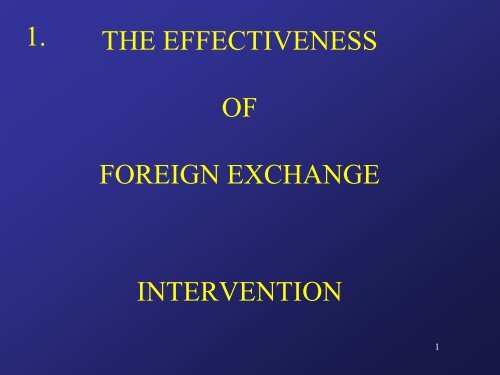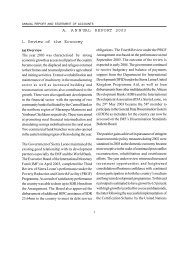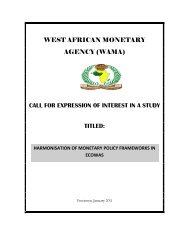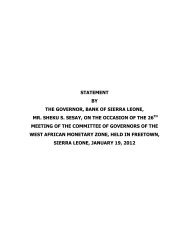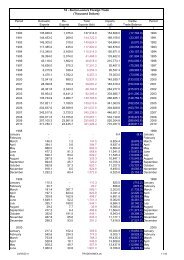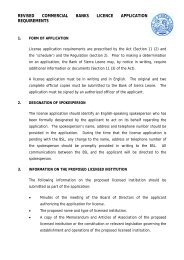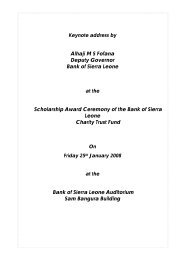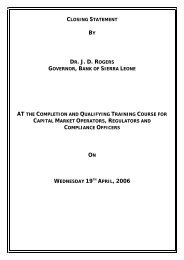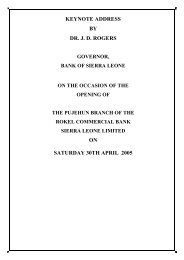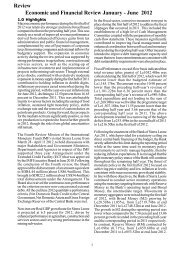Foreign Exchange Intervention - Bank of Sierra Leone
Foreign Exchange Intervention - Bank of Sierra Leone
Foreign Exchange Intervention - Bank of Sierra Leone
You also want an ePaper? Increase the reach of your titles
YUMPU automatically turns print PDFs into web optimized ePapers that Google loves.
1. THE EFFECTIVENESS<br />
OF<br />
FOREIGN EXCHANGE<br />
INTERVENTION<br />
1
STRUCTURE OF PRESENTATION<br />
1. Title Page<br />
2. Definitions<br />
- <strong>Foreign</strong> <strong>Exchange</strong> <strong>Intervention</strong><br />
- <strong>Exchange</strong> Rate<br />
3. Relevance <strong>of</strong> <strong>Foreign</strong> <strong>Exchange</strong> Rate to the Government<br />
4. Development <strong>of</strong> <strong>Foreign</strong> <strong>Exchange</strong> Regimes in <strong>Sierra</strong> <strong>Leone</strong><br />
5. Reasons for <strong>Foreign</strong> <strong>Exchange</strong> <strong>Intervention</strong><br />
6. Why do policy Makers want stability in <strong>Exchange</strong> Rates<br />
7. Drawbacks <strong>of</strong> <strong>Foreign</strong> <strong>Exchange</strong> <strong>Intervention</strong><br />
8. Theoretical Framework <strong>of</strong> <strong>Foreign</strong> <strong>Exchange</strong> <strong>Intervention</strong><br />
9. Mechanics <strong>of</strong> <strong>Foreign</strong> <strong>Exchange</strong> <strong>Intervention</strong><br />
10. Review <strong>of</strong> the Mechanics <strong>of</strong> <strong>Foreign</strong> <strong>Exchange</strong> <strong>Intervention</strong><br />
11. Is <strong>Foreign</strong> <strong>Exchange</strong> <strong>Intervention</strong> Effective or Not<br />
12. The Effectiveness <strong>of</strong> <strong>Foreign</strong> <strong>Exchange</strong> <strong>Intervention</strong><br />
13. Ways <strong>of</strong> measuring the Effectiveness <strong>of</strong> <strong>Foreign</strong> <strong>Exchange</strong> <strong>Intervention</strong><br />
14. Data and Analysis<br />
15. Conclusions<br />
2
2.<br />
FOREIGN EXCHANGE<br />
INTERVENTION<br />
Definition:<br />
Central <strong>Bank</strong>s engage in international<br />
transactions by buying foreign denominated<br />
assets and selling their currency<br />
or by selling foreign assets (from their<br />
international reserves) and purchasing the<br />
domestic currency.These activities can affect<br />
the exchange rate.<br />
3
2. (Cont’d.)<br />
EXCHANGE RATE<br />
Definition<br />
An <strong>Exchange</strong> rate is the price <strong>of</strong> one foreign<br />
currency in term <strong>of</strong> another currency at a<br />
particular date. For example the <strong>of</strong>ficial BSL<br />
<strong>Leone</strong> per US dollar exchange rate as at 16-09-<br />
05 is Le2,883.72 (buying) and Le2941.98<br />
(selling).<br />
4
3.<br />
RELEVANCE OF FOREIGN<br />
EXCHANGE RATES TO THE<br />
GOVERNMENT<br />
<strong>Foreign</strong> <strong>Exchange</strong> rates are <strong>of</strong> particular concern to<br />
governments because changes in foreign exchange<br />
rates affect the value <strong>of</strong> products and financial<br />
instruments. As a result, unexpected or large changes<br />
can affect the health <strong>of</strong> nations’ markets and financial<br />
systems. <strong>Exchange</strong> rate changes also impact a<br />
nations’ international investment flows, as well as<br />
export and import prices. These factors, in turn, can<br />
influence inflation and economic growth. In the light<br />
<strong>of</strong> these different <strong>Exchange</strong> regimes have existed.<br />
5
4. DEVELOPMENTS OF FOREIGN<br />
EXCHANGE REGIMES IN SIERRA LEONE<br />
PERIOD<br />
TYPES OF<br />
REGIMES<br />
EXCHANGE<br />
RATE<br />
COMMENTS<br />
1 1964 - 1978 The <strong>Leone</strong> was pegged<br />
to the Pound Sterling<br />
Le2.00 = GBP1.00<br />
The <strong>Leone</strong> was pegged to the Pound<br />
Sterling due to the stability <strong>of</strong> the<br />
latter.<br />
2 1978 – 1982 The <strong>Leone</strong> was linked<br />
to the IMF’s Special<br />
Drawing Rights (SDR)<br />
3 1982 – 1983 The Two Tier System or<br />
dual <strong>Exchange</strong> Rate<br />
System<br />
Le1.00 = SDR0.731556<br />
Official market determined<br />
rates for Government<br />
transactions Le2.45 =<br />
US$1.00 (commercial<br />
market determined rates for<br />
other transactions<br />
The Pound became very unstable in<br />
1979. This period was referred to as<br />
“The winter <strong>of</strong> discontent” which had<br />
unstabilizing effect on the British<br />
Pounds which resulted into delinking<br />
from the latter.<br />
The depletion <strong>of</strong> the Reserve during<br />
the OAU meetings in the 80s led to the<br />
two tier system to attract more foreign<br />
exchange to beef up the Reserves.<br />
Commercial market rates were<br />
determined at fortnightly auctions held<br />
by the Central bank<br />
6
4. (Cont’d.)<br />
DEVELOPMENTS OF FOREIGN EXCHANGE<br />
REGIMES IN SIERRA LEONE<br />
Period<br />
Types <strong>of</strong><br />
<strong>Exchange</strong><br />
Comments<br />
Regimes<br />
Rate<br />
4 1983 –1986 The <strong>Leone</strong> was<br />
linked to the U S<br />
Dollar<br />
5 1986 – 1990 Flexible Floating<br />
<strong>Exchange</strong> Rate<br />
Le1.00 = US$1.3984 (1983)<br />
Le37.19 = US$1.00 (1986)<br />
Le37.19 = US$1.00 (1986)<br />
Le122.00 = US$1.00 (1990)<br />
Unification <strong>of</strong> the dual rates<br />
The exchange rate was determined<br />
weekly at ‘fixing’ sessions between the<br />
<strong>Bank</strong> <strong>of</strong> <strong>Sierra</strong> <strong>Leone</strong> and the<br />
Commercial <strong>Bank</strong>s<br />
6 1990 to<br />
current<br />
Market<br />
Determined<br />
Le122.00 = US$1.00 (1990)<br />
Le2,914.28 = US$1.00 (2005)<br />
The BSL determines the <strong>Exchange</strong> Rate<br />
to be used in <strong>of</strong>ficial transactions and is<br />
based on the weighted average mid rate<br />
<strong>of</strong> purchases and sales made by<br />
Commercial <strong>Bank</strong>s and <strong>Foreign</strong><br />
<strong>Exchange</strong> Bureaux during the last five<br />
business days and the weekly auction.<br />
Source: Annual Report on <strong>Exchange</strong> Arrangement Arrangements and <strong>Exchange</strong><br />
Restrictions for various years<br />
7
5.<br />
REASONS FOR<br />
FOREIGN EXCHANGE<br />
INTERVENTION<br />
It is to make some contribution towards the<br />
following:<br />
Reduce the extent <strong>of</strong> overshooting.<br />
Reduce the duration <strong>of</strong> overshooting.<br />
To bring about a little more short-term<br />
stability when markets threaten to<br />
overreact to news.<br />
8
5 (Cont’d.)<br />
The latter is amenable to intervention but the first<br />
and second are not. This is so because<br />
intervention cannot be used to correct a<br />
monetary policy imbalance, or to resist<br />
changing fundamentals such as world growth or<br />
commodity prices. However it can be used in the<br />
following circumstances:<br />
‣ A medium term movement based on fundamentals<br />
was going too far, i.e. overshooting; or<br />
‣ A short term overreaction to a piece <strong>of</strong> news that is<br />
intrinsically difficult to interpret. In these<br />
circumstances intervention is said to bring about<br />
stability in exchange rates.<br />
9
6.<br />
WHY DO POLICYMAKERS WANT<br />
STABILITY<br />
IN EXCHANGE RATES?<br />
1. Stability in <strong>Exchange</strong> Rates<br />
More (short and medium term) stability in prices<br />
Planning easier for businesses, individuals<br />
Less uncertainty in general (although exchange rate<br />
stability may imply interest rate instability!)<br />
Smaller countries worry about importing inflation.<br />
Beggar-thy-neighbor trade policies (temporary gains in<br />
competitive advantage with weak currencies)<br />
10
6. (Cont’d.)<br />
WHY DO POLICYMAKERS WANT<br />
STABILITY<br />
IN EXCHANGE RATES?<br />
2. <strong>Intervention</strong> is sometimes used to help avert currency<br />
crises, full scale speculative attacks.<br />
Sharp unexpected currency realignments are costly.<br />
Begs larger question: when is a fixed rate / currency<br />
peg truly unsustainable? If economic fundamentals<br />
are inconsistent with the currency strength,<br />
intervention may not be effective. <strong>Exchange</strong> rate<br />
regime exit strategies need to be developed.<br />
Difficult to determine whether shocks are temporary<br />
or permanent (and if realignment should be avoided).<br />
11
7.<br />
DRAWBACKS OF FOREIGN<br />
EXCHANGE INTERVENTION<br />
• Monetary Policy is relegated to task <strong>of</strong> exchange rate<br />
stabilization. It becomes unavailable for other primary<br />
goals (like output and inflation stabilization)<br />
• <strong>Intervention</strong> can lead to a substantial loss or accumulation<br />
<strong>of</strong> foreign currency reserves. (Total amount <strong>of</strong>fered at the<br />
<strong>Foreign</strong> <strong>Exchange</strong> Auction) = US$260,250,000.00<br />
• Unsustainable regimes may ultimately require large<br />
discreet realignments.<br />
12
THEORETICAL FRAMEWORK OF FX<br />
8.<br />
INTERVENTION<br />
From a simple balance sheet <strong>of</strong> a Central <strong>Bank</strong><br />
the identity given below can be extracted thus:<br />
Change in NFA cb = Change in H- Change in DC.<br />
Where:<br />
NFA=Net <strong>Foreign</strong> Asset<br />
Cb= central bank<br />
H= high-powered money<br />
DC= domestic credit.<br />
13
8. (Cont’d.)<br />
THEORETICAL FRAMEWORK OF FX<br />
INTERVENTION<br />
The above identity shows that a change in<br />
net reserves <strong>of</strong> the monetary authorities is<br />
equal to the excess <strong>of</strong> money creation over<br />
domestic credit creation.<br />
The frame work, although still rather<br />
simple, does suggest the following<br />
scenarios.<br />
14
8. (Cont’d.)<br />
THEORETICAL FRAMEWORK OF FX<br />
INTERVENTION<br />
External deficits or reserve losses can be<br />
controlled.<br />
Secondly, the framework could be used to<br />
explain the mechanics <strong>of</strong> foreign exchange<br />
intervention. How this is done could be<br />
observed as we go through the mechanics<br />
given on the other page.<br />
15
9.<br />
MECHANICS OF FX INTERVENTION<br />
Three Main Tools:<br />
1. Interest Rates or Unsterilized <strong>Intervention</strong><br />
» used by many small countries<br />
When the central bank sells foreign assets, it is said to be purchasing<br />
the domestic currency, and the purchaser <strong>of</strong> the asset has to pay the<br />
central bank with either currency or domestic deposits. In either case,<br />
this decreases the monetary base by the amount <strong>of</strong> the transaction. The<br />
appreciation <strong>of</strong> the domestic currency causes the exchange rate to<br />
increase. Conversely, the central bank can sell the domestic currency<br />
by purchasing foreign assets which increases the monetary base, the<br />
domestic currency depreciates and the exchange rate declines.<br />
2. Sterilized Currency Purchases in Open Market<br />
used by large countries, some small countries<br />
The central bank can <strong>of</strong>fset its international transaction with an<br />
<strong>of</strong>fsetting open market operation. In this case the monetary base and<br />
money supply remain unchanged, so there is no change in exchange<br />
rates.<br />
3. Jawboning / Announcements: Talk, Talk, Talk<br />
Please note that interventions (sterilized or unsterilized) can be accompanied by<br />
statements to clarify the intent <strong>of</strong> the action.
10.<br />
1. The Starting Point<br />
Review <strong>of</strong> the Mechanics <strong>of</strong> FX intervention<br />
Le. – USD @ Le2912.85/USD1.00 (= 0.00034 Dollars per<br />
<strong>Leone</strong>).<br />
A <strong>Bank</strong> <strong>of</strong> <strong>Sierra</strong> <strong>Leone</strong> L A Commercial <strong>Bank</strong> L<br />
------------------------------------------------ --------------------------------------------<br />
Le500M S.L. Gov’t Securities Le1000M <strong>Bank</strong> Reserves Le100M <strong>Bank</strong> Reserves Le250M Private Deposits<br />
USD 400 Currency<br />
(=Le1,165,140)<br />
USD40 Currency (=Le116,514)<br />
Le50 S.L. Gov’t Securities<br />
Le50 Loans<br />
2. <strong>Intervention</strong> to Weaken the Dollar / Support the <strong>Leone</strong>:<br />
BSL Sells Dollars, Buys <strong>Leone</strong>s in Currency Markets<br />
A <strong>Bank</strong> <strong>of</strong> <strong>Sierra</strong> <strong>Leone</strong> L A Commercial <strong>Bank</strong> L<br />
------------------------------------------------ ---------------------------------------------<br />
- USD 4 (Le.11,651.40) -Le.11,651.40 <strong>Bank</strong> Reserves - Le11,651.40 <strong>Bank</strong> Reserves<br />
+ USD 4 (= Le11,651.40)<br />
17
10 (Cont’d.)<br />
REVIEW OF THE MECHANICS OF FX<br />
INTERVENTION<br />
On the day <strong>of</strong> these transactions, Dollar sales put downward<br />
pressure on the dollar’s leone value.<br />
Suppose the BSL does nothing more. What sustains the new, lower<br />
value <strong>of</strong> the dollar after the transaction?<br />
The decline in bank reserves leads to a smaller S.L money supply<br />
and higher S.L interest rates. This maintains the stronger leone.<br />
2. <strong>Intervention</strong> to Weaken the Dollar / Support the leone:<br />
BSL Sells dollars, Buys <strong>Leone</strong> in Currency Markets<br />
A <strong>Bank</strong> <strong>of</strong> <strong>Sierra</strong> <strong>Leone</strong> L A Commercial <strong>Bank</strong> L<br />
------------------------------------------------ ----------------------------------------------<br />
-U.S Dollars 4 (Le11,651.40) -Le11,651.40 <strong>Bank</strong> Reserves<br />
- Le11,651.40 <strong>Bank</strong> Reserves<br />
+U.S $ 4 (=Le11,651.40)<br />
18
10. (Cont’d.)<br />
What if the monetary authority does not want<br />
interest rate changes?<br />
3. Sterilized <strong>Intervention</strong>:<br />
BSL Enters <strong>Sierra</strong> <strong>Leone</strong> Gov’t Securities Market as a Buyer<br />
A <strong>Bank</strong> <strong>of</strong> <strong>Sierra</strong> <strong>Leone</strong> L A Commercial <strong>Bank</strong> L<br />
------------------------------------------------ --------------------------------------------<br />
+ Le11,651.40 S.L Gov’t + Le11,651.40 <strong>Bank</strong> Reserves + Le11,651.40 <strong>Bank</strong> Reserves<br />
Securities<br />
– Le11,651.40 S.L.Gov’t Securities<br />
The net result <strong>of</strong> sterilized intervention is that bank reserves and the<br />
money base are unchanged. As a consequence, interest rates are likely to<br />
be stable.<br />
A <strong>Bank</strong> <strong>of</strong> <strong>Sierra</strong> <strong>Leone</strong> L A Commercial <strong>Bank</strong> L<br />
----------------------------------------------- -------------------------------------------<br />
+ Le11,651.40 S.L. Gov’t Securities + USD 4 Currency (= + Le11,651.40)<br />
- USD 4 Currency (= + Le11,651.40) - Le11,651.40 S.L. Gov’t Securities<br />
19
10. (Cont’d.)<br />
What if the monetary authority does not want<br />
interest rate changes?<br />
But, if S.L interest rates are unchanged, this<br />
leads to questions about why and how the<br />
immediate exchange rate effect (weaker<br />
Dollar) is sustained.<br />
20
11.<br />
IS FOREIGN EXCHANGE INTERVENTION<br />
EFFECTIVE OR NOT?<br />
Proving the effectiveness or otherwise <strong>of</strong><br />
<strong>Foreign</strong> <strong>Exchange</strong> <strong>Intervention</strong> is fraught<br />
with difficulties.<br />
In fact, there existed until very recently a<br />
strong presumption among academic<br />
economists that intervention was<br />
ineffective.<br />
21
11. (Cont’d.)<br />
There were two main planks to this argument. First, there was a<br />
view that the market would get it right without our help<br />
(efficient market hypothesis), and so intervention could only<br />
make things worse. Second, there was a view that central banks<br />
usually lose money through intervention and therefore their<br />
efforts must have been destabilizing.<br />
However, others believed that <strong>Foreign</strong> <strong>Exchange</strong> intervention is<br />
very effective as a policy tool.<br />
There is no disagreement, either theoretical or empirical, that<br />
non-sterilized foreign exchange intervention significantly<br />
affects the exchange rate. A non-sterilized foreign exchange<br />
operation amounts to a change in the domestic supply <strong>of</strong><br />
money, and all models predict that changes in the stock <strong>of</strong><br />
money affect the nominal exchange rate, both in the short run<br />
and in the steady state. The effectiveness <strong>of</strong> non-sterilized<br />
intervention is clearly evident in the empirical exchange rate<br />
models (Driskill and Sheffrin (1981) and Frenkel (1981).
12.<br />
THE EFFECTIVENESS OF FOREIGN<br />
EXCHANGE INTERVENTION.<br />
This simply means how quickly the Central<br />
<strong>Bank</strong> could curb the extent and duration <strong>of</strong><br />
overshooting and bring about a little more<br />
short-term stability when the market<br />
threatens to overreact to news.<br />
23
WAYS OF MEASURING THE<br />
13. EFFECTIVENESS OF FOREIGN<br />
EXCHANGE INTERVENTION.<br />
The Friedman “pr<strong>of</strong>it test” is one way <strong>of</strong> looking<br />
at the effectiveness <strong>of</strong> foreign exchange<br />
intervention. Friedman (1953) argued that a<br />
central bank, which was stabilizing the exchange<br />
rate, would tend to buy foreign exchange when<br />
its price was low, and sell when its price was<br />
high, and hence its operations would be<br />
pr<strong>of</strong>itable.<br />
24
13.(Cont’d.)<br />
Secondly, using market participant’s response to the<br />
auction (intervention) rate is another.<br />
The Auction determined rate serves as a reference rate<br />
by other foreign exchange market operators namely<br />
commercial banks, bureaus, parallel market, and others.<br />
In the light <strong>of</strong> this, to give us an indication as to how<br />
effective foreign exchange intervention by the <strong>Sierra</strong><br />
<strong>Leone</strong> monetary authority been over the period 2000 to<br />
current, the graph in table 1 shows the comparison <strong>of</strong><br />
Auction Rate with other exchange rates determined by<br />
other foreign exchange operators in the market.<br />
25
Jul.05<br />
Apr.05<br />
Jan.05<br />
Oct.04<br />
3500.00<br />
3000.00<br />
2500.00<br />
2000.00<br />
1500.00<br />
1000.00<br />
DATA AND ANALYSIS<br />
Auction rates and Other foreign exchange rates<br />
26<br />
Jul.01<br />
Oct.01<br />
Jan.02<br />
Apr.02<br />
Jul.02<br />
Oct.02<br />
Jan.03<br />
Apr.03<br />
Jul.03<br />
Oct.03<br />
Jan.04<br />
Apr.04<br />
Jul.04<br />
End month period<br />
Auction Rate C/banks Sell Bureaux Sell Parallel Sell<br />
Apr.01<br />
Jan.01<br />
Oct.00<br />
Jul.00<br />
Apr.00<br />
Jan.00<br />
Le/USD rates


